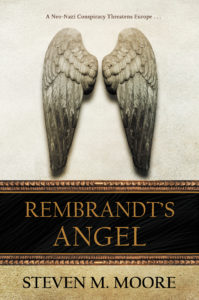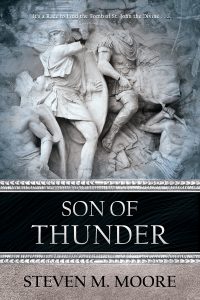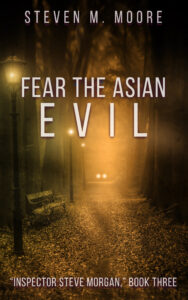Why British-style mysteries?
Here’s a question you might be dying to ask: How is it that an old half-Irish curmudgeon (my desktop’s scene is a photo I took of Ireland’s Blarney Castle!) enjoys writing about British detectives? (Some of them are Celtic, though—Irish, Scottish, and Welsh.) I started down that road with Esther Brookstone and have written twelve novels that can be called British-style mysteries, which include the three “Inspector Steve Morgan” novels as the most recent ones.
The answer isn’t what you might think. While I’ve always been an internationally oriented author—about half the “Chen & Castilblanco” series takes place outside the US—and I’ve spent a lot of time outside the country, that international perspective, while unusual among American authors, that doesn’t completely explain my recent focus on British-style sleuthing. In fact, there are two more important factors: One, I loved reading Christie’s stories as a kid, and survived Covid-19 by reading entire series of British-style mysteries; and two, Asimov’s two sci-fi mysteries, Caves of Steel and The Naked Sun, also read at an early age, showed me that mystery tales could be more universal than any other category of fiction. Christie barely probed into the possibilities. (That binge-reading didn’t either.)
 Rembrandt’s Angel, the first book in the “Esther Brookstone Art Detective” series was written more as a personal challenge to myself to put together Miss Marple and Hercule Poirot, Christie’s two famous sleuths, and create a twenty-first century crime-fighting duo, something I always considered an error Christie made. (Brookstone is a modern Miss Marple; and her paramour and later husband, van Coevorden, is a modern Hercule Poirot.) But those two more general motivations remained.
Rembrandt’s Angel, the first book in the “Esther Brookstone Art Detective” series was written more as a personal challenge to myself to put together Miss Marple and Hercule Poirot, Christie’s two famous sleuths, and create a twenty-first century crime-fighting duo, something I always considered an error Christie made. (Brookstone is a modern Miss Marple; and her paramour and later husband, van Coevorden, is a modern Hercule Poirot.) But those two more general motivations remained.
A writer-friend among Black Opal Book’s authors writes mysteries set in ancient Egypt. Another sci-fi writer writes excellent mysteries set far in the future. (I think I’ve reviewed both these authors’ novels a while ago.) Many of my own Dr. Obregon stories are sci-fi mysteries, and, in my binge-reading, I’ve enjoyed mysteries set in the nineteenth century, some even written by Americans. In other words, mystery provides a large umbrella to tuck stories under. Authors and readers should never forget that mystery has that positive influence on fiction literature.
Yes, mystery stories’ characters can be from any country and any ethnicity, and their settings can be from any time and place, even in outer space.
 But in my recent works, I returned to mystery’s roots more as an homage: Christie’s Britain, with new twenty-first century wrappings. Despite reforms and reorganizations (the NCA and Police Scotland represent two major examples), policing in the UK is still steeped in tradition. The “Inspector Morgan” novels are much more police procedurals than Rembrandt’s Angel and Son of Thunder, the first two novels in the “Esther Brookstone” series. I’m guessing that this turn in my writing journey might not resonate with UK readers. So be it. It’s a detour I needed to take to round out that part of my writing journey into the strange lands of mystery and crime writing.
But in my recent works, I returned to mystery’s roots more as an homage: Christie’s Britain, with new twenty-first century wrappings. Despite reforms and reorganizations (the NCA and Police Scotland represent two major examples), policing in the UK is still steeped in tradition. The “Inspector Morgan” novels are much more police procedurals than Rembrandt’s Angel and Son of Thunder, the first two novels in the “Esther Brookstone” series. I’m guessing that this turn in my writing journey might not resonate with UK readers. So be it. It’s a detour I needed to take to round out that part of my writing journey into the strange lands of mystery and crime writing.
***
 Comments are always welcome. (Please follow the rules on my “Join the Conversation” web page. If you don’t, your comment is considered spam.)
Comments are always welcome. (Please follow the rules on my “Join the Conversation” web page. If you don’t, your comment is considered spam.)
Fear the Asian Evil. This third book in the “Inspector Steve Morgan” series might seem ripped from the headlines after reports that President Biden strongly warned President-for-Life Xi about invading Taiwan. The book deals more with China’s long-standing policy of industrial espionage—they’d rather steal ideas than have to invent them—and fomenting unrest in western democracies. While it starts out as a typical police procedural—the sister-in-law of Morgan’s sergeant is shot—it acquires a spy-fi flavor that goes far beyond Christie’s typical British-style mysteries. Available wherever quality ebooks are sold (but not on Amazon).
Around the world and to the stars! In libris libertas!
